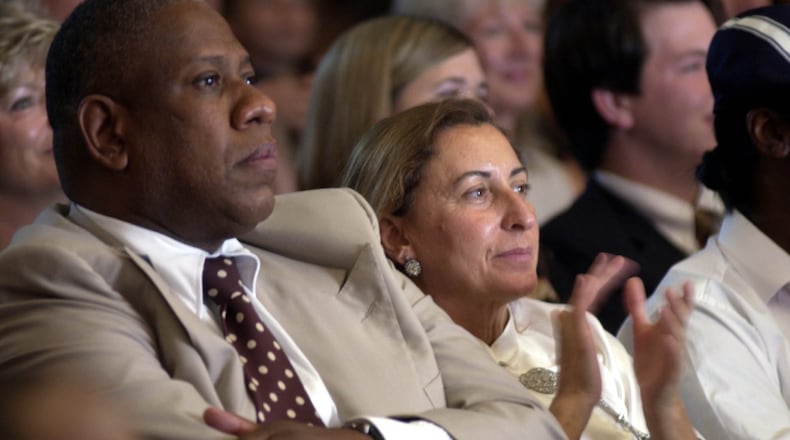The grandson of a cleaning lady and a sharecropper from Durham, North Carolina, André Leon Talley stood on the steps of the Metropolitan Museum of Art in New York City in the early 1970s with a letter of introduction that he hoped would help him earn a place as an unpaid volunteer in the museum’s Costume Institute, helmed by the iconic former Vogue editor Diana Vreeland.
Forty years later he would return to those steps to conduct red carpet interviews with fashion designers and celebrities as a veteran fashion editor and the creative director of American Vogue. In his latest memoir, "The Chiffon Trenches," 71-year-old Talley chronicles the mountains and valleys of his five decades in the industry — from working with Andy Warhol at Interview magazine to his resignation as the Paris correspondent for Women's Wear Daily due to the leadership's overt racism.
The book details those crucible moments that never make it into the articles that bear his byline, such as his failed lap-band weight loss surgery, the personal slights (like being called “Queen Kong”) and the larger institutionalized racism that ensured few blacks would ever make it to the pinnacle of this fickle but glamorous world. Known for his wide knowledge of historic references and his aesthetic appreciation for elegance, Talley had a front row seat to the sometimes outrageous behaviors of power brokers in the industry including his former boss Vogue editor Anna Wintour, supermodel Naomi Campbell and designers Karl Lagerfeld and John Galliano.
Speaking last month from his home in White Plains, New York, where he is social distancing during the COVID-19 pandemic, Talley was upbeat because it was his publication day. He was buoyed by the opportunity to share his stories growing up through “adversarial things — sexual child abuse, obesity, loneliness” and having “survived the world of style.”
Talley was raised by his grandmother, Bennie Frances Davis, who he credits with instilling high standards and an appreciation of simple pleasures. Luxury, he insists, doesn’t have to be expensive. One of his favorite things is starched sheets. In his youth he recalls that they were boiled in a big black wash pot and later pressed with Argo corn starch from a red and white box. To hear him tell it, there was no greater joy than sliding into fresh, cool, clean sheets for a night’s rest. “No one starches things at home like they did in those days,” he says.
During his youth in the segregated South, Talley sought comfort by walking to the library and escaping into the glossy pages of Vogue, a world where “bad things never happened.” The knowledge he gained during that time, combined with his acute sense of observation and infallible memory, made him an invaluable resource of fashion history and cultural touchstones during his time at fashion magazines.
Little did Talley know when he was writing “The Chiffon Trenches” that the fashion world as it existed for him would not be there much longer — with COVID-19 hastening its dying breaths. Runway shows are on pause. Air travel is mostly grounded. Many in the fashion industry wonder who will be left with a job now that the economy is in ruins. Talking about couture clothing when millions are without jobs seems like an exercise in cruelty.
And little did either one of us know that a week after our conversation, George Floyd would be killed in Minneapolis and the Black Lives Matter movement would sweep the country with protests.
In his memoir, Talley addresses some of the challenges he encountered because of skin color.
“It’s a book about a black man who absolutely invented himself from his education and his background in the racist Jim Crow South, and moved into the forefront of the world of fashion, and became a pioneer through Vogue, and survived the world of Vogue, and was perhaps spit out from Vogue,” he says. “But I still am soldiering on in the chiffon trenches of life.”
Talley has been criticized by some for not doing more to champion diversity in the industry.
“People weave what they want to into your own narrative,” Talley says. “I think that people expected me as a black man, being the only black man, I was supposed to be some underground railroad for black people in the world of fashion. This does not exist. And I’m getting criticized today for that.”
Early leaks of the memoir prompted media buzz over Talley’s caustic comments about Wintour. “She’s not capable of simple human kindness,” he writes. About the cancellation of his Vogue podcast and Vogue’s failure to renew his contract as a red-carpet correspondent, Talley writes, “No explanation or financial severance compensation. Just sphinx-like silence from Anna Wintour. She decimated me with this silent treatment so many times. That is just the way she resolves any issue.”
But he maintains that “The Chiffon Trenches” is his narrative and while he has critical things to say of his colleague, they are not a dominant thread in the book.
Now that his career as a fashion journalist appears to be waning, Talley is focused on his legacy. The South has come the closest to giving him the recognition that he believes he deserves as a pioneer in the world of fashion. For 20 years he has been a member of the board of trustees at the Savannah College of Art and Design, and he calls Savannah his “second home.”
For his role in bringing American fashion to the forefront, the school’s achievement award was renamed in his honor in 2001. It is “a wonderful platform for me to honor titans of fashion,” he says. Past recipients include Stephen Burrows, Vivienne Westwood, Francisco Costa and Ralph Rucci. There is also an André Leon Talley Gallery at the SCAD Museum of Art in Savannah.
“The Chiffon Trenches” is story of a man who dedicated everything he had to fashion only to discover that world — with its eccentricities and cast of self-serving, cut-throat characters who routinely pull stunts like Wintour’s — did not love him back.
“I had internalized my childhood abuse and was too afraid now to have a relationship,” Talley writes. “I put love in the back of my mind. Instead, I continued to focus on my career and never even considered the need for a separate social life until it was too late to really have one. My friends were my work friends, Betty Catroux, Loulou de la Falaise and Karl (Lagerfeld). My social life was attending fittings with São Schlumberger. I thought myself so clever then.”
The man that dedicated everything he had to fashion has his regrets. He realizes that closure with some of his former fashion colleagues may never come. But that doesn’t keep someone who for so many years was the only black face in the room from advocating for his place among the fashion gods.
NONFICTION
by André Leon Talley
Ballantine Books
304 pages, $28
About the Author
Keep Reading
The Latest
Featured


